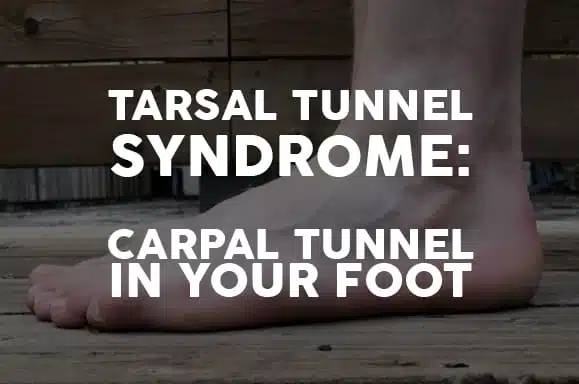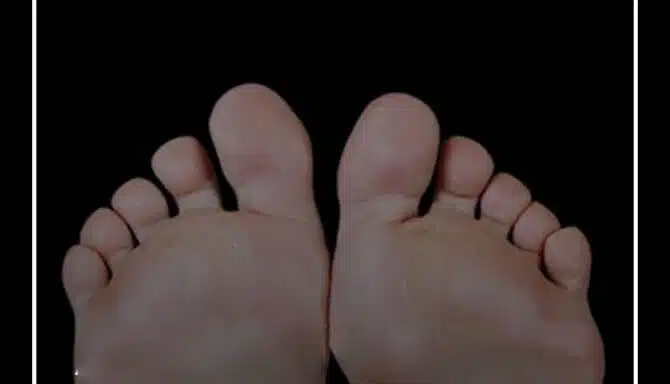Carpal tunnel, but in your foot.
Tarsal tunnel syndrome is a relatively common foot condition that affects the ankle. Specifically, tarsal tunnel syndrome is the result of a damaged posterior tibial nerve.
Overview
Tarsal tunnel syndrome is the most common nerve entrapment of the ankle. It compares to carpal tunnel syndrome, the condition’s equivalent in the hand. Carpal tunnel syndrome occurs when the median nerve compresses. Symptoms include numbness, tingling and weakness in the hand and arm.
OK, back to the tarsal tunnel.
The tarsal tunnel is a narrow space on the inside of the ankle next to the ankle bones. The tunnel is covered with a thick ligament that helps contain its inner workings – veins, arteries, tendons, and nerves. Notably, the tibial nerve runs through the tarsal tunnel.
Tarsal tunnel syndrome occurs when the tarsal tunnel is compressed. Imagine your squeezing a casing of wires. The more pressure against the case, the more stress put onto fillings inside. In this case, those would be the nerves, arteries, and tendons inside.
Symptoms include sharp, shooting pain, pins and needles, or a burning sensation on the inside of your foot, close to where your foot meets your ankle. Some say that pain can be severe enough to cause a person to limp, and individuals may describe a radiating pain that cannot be localized to one spot.
Causes
Tarsal tunnel syndrome can result in pain because of direct damage to the tibial nerve.
The following can contribute to tarsal tunnel syndrome:
- Flat feet: fallen arches and flat feet can stretch the tibial nerve;
- Growths in the tarsal tunnel (bone spurs and cysts);
- Varicose veins: can cause compression on the nerve;
- Inflammation;
- Osteoarthritis;
- Overpronation: overpronating and inward rotation of the foot can strain the ankle and lead to pain in and around the tarsal tunnel. Overpronation can also stretch out the tibial nerve;
- Improper shoes: small shoes can cause undue stress around the heel (and elsewhere) compressing the tarsal tunnel;
- Ankle injuries: sprains, stress fractures, and other lower leg and ankle injuries can cause inflammation and swelling.
A medical professional can diagnose TTS (tarsal tunnel syndrome) through an exam, x-rays, or electrical testing. Typically, an MRI and Nerve Conduction Velocity test is done to diagnose TTS.
Often, there are numerous causes. Or, the cause is unclear. Runner’s World reports that about 50% of the time, a cause for Tarsal tunnel syndrome cannot be identified. In these cases, if a cause is not immediately clear, consult a doctor for more information.
Treatment
Tarsal tunnel syndrome can be managed effectively, especially if treated early.
- Swap out your shoes: small shoes can put undue pressure on the inner ankle;
- Custom-made orthotics: custom-made orthotics (which we do in-store) can help reduce the effects of overpronation;
- Anti-inflammatories: swelling in the foot can lead to compression of the tarsal tunnel;
- Compression socks: akin to anti-inflammatories, the goal here is to reduce swelling of the ankle and lower leg;
- As a last resort, surgery is an option.
- One such surgery is a tarsal tunnel release. In this case, the doctor “creates an opening behind the ankle that extends down to the arch of the foot. The surgeon carefully divides the ligament so it is not pressing against the tibial nerve.”
If symptoms persist or worsen, consult a healthcare professional for a proper diagnosis.
Prevention
- Improve flexibility of the lower leg and foot;
- Schedule a shoe fitting: finding the right shoes (and the right fit) is essential for the health of your feet. Small shoes can lead to tarsal tunnel syndrome. Additionally, ill-fitting shoes can cause a whole slew of other foot conditions;
- Physical therapy and strengthening.
- Heel raises
- Calf stretches
- Balancing exercises
Tarsal tunnel syndrome is the less-talked-about version of carpal tunnel syndrome.
If you feel a burning sensation or pain on the inside of your ankle or experience chronic ankle swelling, you may have tarsal tunnel syndrome.
For more information, and to schedule a shoe-fitting session or to learn more about custom foot orthotics, fill out the form below, or stop by the store. We’re located at 2481 Bloor St. West in Toronto.










